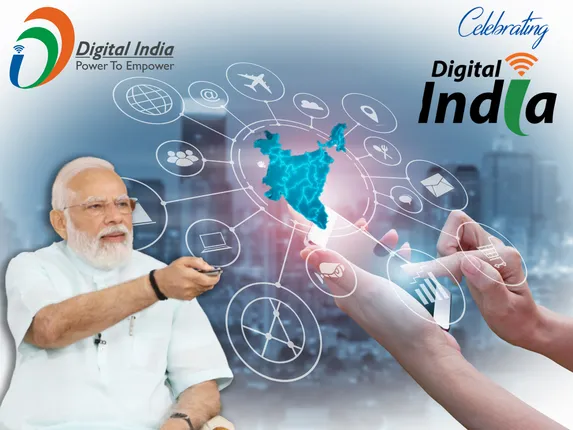The advent of the 21st century brought forth a paradigm shift in global landscapes, pivoting from traditional methodologies to a more digitalized approach. Central to this transformation in India is the Digital India campaign, an ambitious venture aiming to reform the nation’s digital landscape. Launched on 1st July 2015, this initiative stands as a testament to India’s commitment to embrace the digital age while ensuring inclusivity for all its citizens.
A key aspect of Digital India involves building a strong digital foundation. This means improving fast internet access in rural areas, setting up service centers in villages, and installing public Wi-Fi spots.
Historical Context & Launch
Understanding the Digital India initiative requires delving into its inception. The Indian government, under the leadership of Prime Minister Narendra Modi, identified the need to bridge the vast digital divide existing between urban metropolises and remote rural areas. To rectify this imbalance, the project was unveiled at the Indira Gandhi Indoor Stadium, Delhi, graced by luminaries from various industries, who came forward to share insights and pledge support.
Digital Infrastructure: The Backbone
The primary pillar of Digital India is constructing robust digital infrastructure. Aimed at every Indian, this infrastructure seeks to provide high-speed internet connectivity, ensuring no citizen is left in the digital dark. The Bharat Broadband Network Limited (BBNL) takes the lead, working relentlessly to reach even the remotest corners, ensuring internet connectivity transcends geographical challenges. This digital web aims to be the lifeline connecting diverse communities, fostering communication, and bringing services and opportunities to one’s doorstep.
Digital Literacy: Empowering the Masses
A powerful infrastructure is futile without the skills to utilize it. Recognizing this, Digital India places paramount importance on digital literacy. The initiative strives to arm every Indian, irrespective of age or background, with the tools and knowledge to navigate the digital realm. This means transforming traditional classrooms, introducing e-learning platforms, and ensuring that even rural areas have access to digital tools and training.
E-Governance: Revolutionizing Administration
E-Governance forms the crux of this initiative. By transitioning essential governmental services online, processes are streamlined and made more transparent. Whether it’s academic document verification, medical services, or financial transactions, the digital overhaul ensures efficiency and minimizes bureaucratic red tape. Such a system prioritizes citizens, making their interactions with government smooth and hassle-free.
Economic Impacts and Global Collaborations
The economic repercussions of Digital India are profound. By establishing a tech-savvy environment, it beckons global investors and businesses to partake in India’s digital revolution. Leading conglomerates, both domestic like Reliance and Tata, and international entities, have pledged significant investments, recognizing the initiative’s potential to redefine business landscapes.
Furthermore, this digital pivot augments job opportunities manifold. With a burgeoning IT sector and a spike in demand for digital services, there’s a projected surge in employment, fostering economic growth.
Challenges and the Path Forward
While the prospects are promising, the journey is laden with challenges. Ensuring consistent high-speed connectivity across diverse terrains, combating cyber threats, and addressing resistance from traditionally non-digital communities are just some hurdles.
Nevertheless, the Digital India vision, backed by unwavering commitment and strategic planning, promises a future where technology and tradition coalesce harmoniously. In bridging the digital divide, India isn’t merely adopting technology; it’s weaving it into the very fabric of its rich cultural tapestry, ensuring a future that’s advanced yet rooted in its glorious heritage. As Digital India galvanizes into full swing, it heralds a new dawn – one of prosperity, inclusivity, and unprecedented growth.

